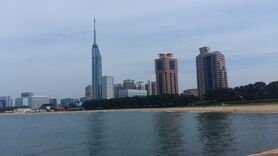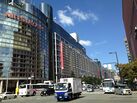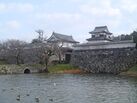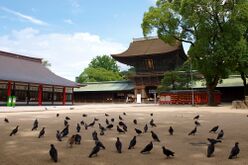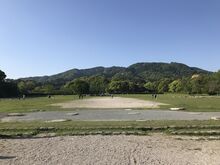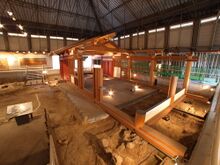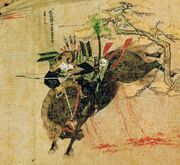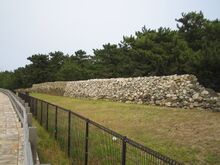فوكوؤكا
Fukuoka
福岡市 | |
|---|---|
| Fukuoka City | |
From top left: Seaside Momochi within Fukuoka Tower, Tenjin area in Chūō-ku, Fukuoka Castle, Hakozaki Shrine, Hakata Station, Bayside Place Hakata Port, and Fukuoka PayPay Dome | |
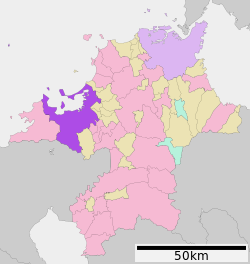 Location of Fukuoka in Fukuoka | |
| الإحداثيات: 33°35′N 130°24′E / 33.583°N 130.400°E | |
| Country | Japan |
| Region | Kyushu |
| Prefecture | Fukuoka Prefecture |
| First official recorded | 57 AD |
| City Settled | April 1, 1889 |
| الحكومة | |
| • Mayor | Sōichirō Takashima (since December 2010) |
| المساحة | |
| • Designated city | 343٫39 كم² (132٫58 ميل²) |
| التعداد (June 1, 2019) | |
| • Designated city | 1٬588٬924 |
| • الكثافة | 4٬600/km2 (12٬000/sq mi) |
| • العمرانية [1] (2015) | 2٬565٬501 (5th) |
| منطقة التوقيت | UTC+9 (Japan Standard Time) |
| – Tree | Camphor laurel |
| – Flower | Camellia |
| – Bird | Black-headed gull |
| الموقع الإلكتروني | www |
| فوكوؤكا | |||||
|---|---|---|---|---|---|
 "Fukuoka" in kanji | |||||
| Japanese name | |||||
| Kanji | 福岡 | ||||
| Hiragana | ふくおか | ||||
| Katakana | フクオカ | ||||
| |||||
فوكو-أوكا أو فوكوكا (بالـيابانية: 福岡市) هي مدينة في اليابان، وعاصمة المحافظة التي تحمل نفس الاسم (محافظة فوكوأوكا)، تقع في شمال شرقي جزيرة "كيوشو" (في أقصى جنوب البر الياباني)، كما تطل على "خليج فوكوكا".
Fukuoka (福岡市, Fukuoka-shi, تـُنطق [ɸɯ̥kɯoka̠ꜜɕi]) is the sixth-largest city in Japan, the second-largest port city after Yokohama, and the capital city of Fukuoka Prefecture, situated on the northern shore of the Japanese island of Kyushu. The city is built along the shores of Hakata Bay, and has been a center of international commerce since ancient times. The area has long been considered the gateway to the country, as it is the nearest point among Japan's main islands to the Asian mainland. Although humans occupied the area since the Jomon period, some of the earliest settlers of the Yayoi period arrived in the Fukuoka area. The city rose to prominence during the Yamato period. Because of the cross-cultural exposure, and the relatively great distance from the social and political centers of Kyoto, Osaka, and later, Edo (Tokyo), Fukuoka gained a distinctive local culture and dialect that has persisted to the present.
Fukuoka is the most populous city on the island, followed by Kitakyushu. It is the largest city and metropolitan area west of Keihanshin. The city was designated on April 1, 1972, by government ordinance. Greater Fukuoka, with a population of 2.5 million people (2005 census), is part of the heavily industrialized Fukuoka–Kitakyushu zone.
اعتبارا من 2015[تحديث], Fukuoka is Japan's sixth largest city, having passed the population of Kobe.[2] In July 2011, Fukuoka surpassed the population of Kyoto. Since the founding of Kyoto in 794, this marks the first time that a city west of the Kinki region has a larger population than Kyoto.
التاريخ
قبل التاريخ
Exchanges from the continent and the Northern Kyushu area date as far back as Old Stone Age.[3] It has been thought that waves of immigrants arrived in Northern Kyushu from mainland Asia.[4] Several Kofun exist.
Fukuoka was sometimes called the Port of Dazaifu (大宰府), 15 km (9 mi) southeast from Fukuoka. Dazaifu was an administrative capital in 663 A.D., but a historian proposed that a prehistoric capital was in the area.[5] Ancient texts, such as the Kojiki, Kanyen (found in Dazaifu) and archaeology confirm this was a critical place in the founding of Japan. Some scholars[6] claim that it was the first place outsiders and the Imperial Family set foot, but like many early Japan origin theories, it remains contested. Central Fukuoka is sometimes still referred as Hakata which is the name of the central ward.
In 923, the Hakozaki-gū in Fukuoka was transferred from Daibu-gū in Daibu (大分), 16 km (10 mi) northeast from Dazaifu, the origin of Usa Shrine and established as a branch of the Usa Shrine at Fukuoka.[7] In Ooho (大保), 15 km (9 mi) south from Dazaifu, there are remains of a big ward office with a temple, because in ancient East Asia, an emperor must have three great ministries (大宰, 大傳 and 大保). In fact, there is a record in Chinese literature that a king of Japan sent a letter in 478 to ask the Chinese emperor's approval for employing three ministries. In addition, remains of the Korokan (鴻臚館, Government Guest House) were found in Fukuoka underneath a part of the ruins of Fukuoka Castle.
Mongol invasions (1274–1281)
Kublai Khan of the Mongol Empire turned his attention towards Japan starting in 1268, exerting a new external pressure on Japan with which it had no experience. Kublai Khan first sent an envoy to Japan to make the Shogunate acknowledge Khan's suzerainty.[8] The Kamakura shogunate refused. Mongolia repeatedly sent envoys thereafter, each time urging the Shogunate to accept their proposal, but to no avail.
In 1274, Kublai Khan mounted an invasion of the northern part of Kyushu with a fleet of 900 ships and 33,000 troops, including troops from Goryeo on the Korean Peninsula.[9] This initial invasion was compromised by a combination of incompetence and severe storms. After the invasion attempt of 1274, Japanese samurai built a stone barrier 20 km (12 mi) in length bordering the coast of Hakata Bay in what is now the city of Fukuoka. The wall, 2–3 metres in height and having a base width of 3 metres, was constructed between 1276 and 1277, and was excavated in the 1930s.
Kublai sent another envoy to Japan in 1279. At that time, Hōjō Tokimune of the Hōjō clan (1251–1284) was the Eighth Regent. Not only did he decline the offer, but he beheaded the five Mongolian emissaries after summoning them to Kamakura. Infuriated, Kublai organized another attack on Fukuoka Prefecture in 1281, mobilizing 140,000 soldiers and 4,000 ships. The Japanese defenders, numbering around 40,000, were no match for the Mongols and the invasion force made it as far as Dazaifu, 15 km (9 mi) south of the city of Fukuoka. However, the Japanese were again aided by severe weather, this time by a typhoon that struck a crushing blow to the Mongolian troops, thwarting the invasion.
It was this typhoon that came to be called the Kamikaze (Divine Wind), and was the origin of the term Kamikaze used to indicate suicide attacks by military aviators of the Empire of Japan against Allied naval vessels during World War II.
الجغرافيا
يجتازها نهر "ناكا" ، شيدت على ضفتها الغربية" قلعة فوكويوكا" (ومنها استمدت اسمها)، ويرجع تاريخها إلى سنة 1601 م، وكانت مقرا لأحد الزعماء الإقطاعيين الكبار، على ضفتها الشرقية يقع "هاكاتا"، حي الأعمال والذي يعود إلى القرن السابع للميلاد، حينما كانت المدينة معبرا لليابان إلى الصين، و مدينة "فوكوكا" أقرب الموانىء اليابانية إلى السواحل الآسيوية.
| بيانات المناخ لـ Fukuoka (1991−2020 normals, extremes 1890−present) | |||||||||||||
|---|---|---|---|---|---|---|---|---|---|---|---|---|---|
| الشهر | ينا | فب | مار | أبر | ماي | يون | يول | أغس | سبت | أكت | نوف | ديس | السنة |
| القصوى القياسية °س (°ف) | 21.5 (70.7) |
24.3 (75.7) |
26.3 (79.3) |
30.1 (86.2) |
32.3 (90.1) |
37.3 (99.1) |
38.3 (100.9) |
38.1 (100.6) |
37.1 (98.8) |
33.3 (91.9) |
28.2 (82.8) |
26.0 (78.8) |
38.3 (100.9) |
| متوسط القصوى اليومية °س (°ف) | 10.2 (50.4) |
11.6 (52.9) |
15.0 (59.0) |
19.9 (67.8) |
24.4 (75.9) |
27.2 (81.0) |
31.2 (88.2) |
32.5 (90.5) |
28.6 (83.5) |
23.7 (74.7) |
18.2 (64.8) |
12.6 (54.7) |
21.3 (70.3) |
| المتوسط اليومي °س (°ف) | 6.9 (44.4) |
7.8 (46.0) |
10.8 (51.4) |
15.4 (59.7) |
19.9 (67.8) |
23.3 (73.9) |
27.4 (81.3) |
28.4 (83.1) |
24.7 (76.5) |
19.6 (67.3) |
14.2 (57.6) |
9.1 (48.4) |
17.3 (63.1) |
| متوسط الدنيا اليومية °س (°ف) | 3.9 (39.0) |
4.4 (39.9) |
7.2 (45.0) |
11.5 (52.7) |
16.1 (61.0) |
20.3 (68.5) |
24.6 (76.3) |
25.4 (77.7) |
21.6 (70.9) |
16.0 (60.8) |
10.6 (51.1) |
5.8 (42.4) |
14.0 (57.2) |
| الصغرى القياسية °س (°ف) | −6.0 (21.2) |
−8.2 (17.2) |
−4.7 (23.5) |
−1.4 (29.5) |
1.4 (34.5) |
4.3 (39.7) |
13.8 (56.8) |
15.4 (59.7) |
7.9 (46.2) |
0.4 (32.7) |
−2.1 (28.2) |
−5.4 (22.3) |
−8.2 (17.2) |
| متوسط تساقط الأمطار mm (inches) | 74.4 (2.93) |
69.8 (2.75) |
103.7 (4.08) |
118.2 (4.65) |
133.7 (5.26) |
249.6 (9.83) |
299.1 (11.78) |
210.0 (8.27) |
175.1 (6.89) |
94.5 (3.72) |
91.4 (3.60) |
67.5 (2.66) |
1٬686٫9 (66.41) |
| متوسط هطول الثلج cm (inches) | 1 (0.4) |
1 (0.4) |
0 (0) |
0 (0) |
0 (0) |
0 (0) |
0 (0) |
0 (0) |
0 (0) |
0 (0) |
0 (0) |
0 (0) |
2 (0.8) |
| Average precipitation days (≥ 0.5 mm) | 11.0 | 10.7 | 11.4 | 10.8 | 9.8 | 12.7 | 12.4 | 11.2 | 11.0 | 7.9 | 9.9 | 10.2 | 128.9 |
| متوسط الرطوبة النسبية (%) | 63 | 62 | 63 | 64 | 67 | 75 | 75 | 72 | 73 | 68 | 66 | 63 | 68 |
| Mean monthly ساعات سطوع الشمس | 104.1 | 123.5 | 161.2 | 188.1 | 204.1 | 145.2 | 172.2 | 200.9 | 164.7 | 175.9 | 137.3 | 112.2 | 1٬889٫4 |
| متوسط مؤشر فوق البنفسجية | 3 | 4 | 6 | 8 | 9 | 10 | 11 | 10 | 8 | 6 | 4 | 3 | 7 |
| Source: Japan Meteorological Agency[10] and Weather Atlas[11] | |||||||||||||
المدينة
لازال السور الدفاعي القديم والذي يبلغ ارتفاعه ثلاثة (3) أمتار ماثلا للعيان في بعض الأماكن على ضفاف خليج "هاكاتا". شيد السور في القرن الثالث عشر الميلادي، لحماية المدينة من الغزوات المغولية.
من أهم المعاهد فيها: جامعة كيوسو (1911 م) وجامعة فوكوكا (1934 م) وكلاهما تقعان داخل المدينة.
الاقتصاد
تتواجد بها صناعات كثيرة: منسوجات الحرير، الدمى، الآلات الميكانيكية، الورق، المعادن والتجهيزات الكهربائية.
International relations
Fukuoka has ten sister cities.[12]
 Atlanta, United States (since February 2005)
Atlanta, United States (since February 2005) Auckland, New Zealand (since June 1986)
Auckland, New Zealand (since June 1986) Bordeaux, France (since November 1982)[13][14]
Bordeaux, France (since November 1982)[13][14] Busan, South Korea (since February 2007)
Busan, South Korea (since February 2007) Delhi, India (since November 2007, friendship city)[15]
Delhi, India (since November 2007, friendship city)[15] Guangzhou, China (since February 1979)[16]
Guangzhou, China (since February 1979)[16] Ipoh, Malaysia (since March 1989)
Ipoh, Malaysia (since March 1989) Oakland, United States (since October 1962)
Oakland, United States (since October 1962) Naples, Italy (since October 1983)
Naples, Italy (since October 1983) Qingdao, China (since February 2003)
Qingdao, China (since February 2003) Yangon, Myanmar (since December 2016)
Yangon, Myanmar (since December 2016)
The city established the Asian Pacific City Summit in 1994. It consists of 26 Asia-Pacific cities. The Asian Pacific Children's Convention was established in Fukuoka in 1988.[17]
Notable people
- Jirō Akagawa (novelist)
- Aska (singer) (Chage and Aska)
- Sonny Chiba (actor, singer, film producer, film director, and martial artist)
- Kaibara Ekken (Neo-Confucianist philosopher)
- Noriko Fukuda (TV announcer)
- Kenji Hamada (voice actor)
- Ayumi Hamasaki (J-pop singer)
- Angela Harry (model and actress)
- Riko Higashio (professional golfer)
- Kiyoshi Hikawa (enka singer)
- Kōki Hirota (politician: 32nd Prime Minister of Japan)
- HKT48 (idol group)
- Yōsuke Ideguchi (Footballer for Leeds United)
- Elaiza Ikeda (model and actress)
- Erina Ikuta (J-pop singer and member of Morning Musume)
- Tomo Inouye (medical doctor)
- Ryo Ishibashi (actor, musician)
- Sui Ishida (manga artist)
- Gakuryū Ishii (film director)
- Kanikapila (rock band)
- Ai Kawashima (singer-songwriter)
- Yoshinori Kobayashi (manga artist)
- Masamune Kusano (vocalist of Spitz)
- Yumeno Kyūsaku (novelist)
- Misia (J-pop singer)
- Kento Miyahara (professional wrestler)
- Ryutaro Nakahara (DJ, musician, composer, arranger)
- Kenzo Nakamura (Judo athlete)
- Katsuhiko Nakajima (professional wrestler)
- Ai Nonaka (voice actor)
- Yukari Oshima (actress)
- Victoria Principal (American actress)
- Noriko Sakai (singer and actress)
- Nao Sakuma (principal dancer with Birmingham Royal Ballet)
- Kensuke Sasaki (professional wrestler)
- Sayuri (singer-songwriter)
- Kōji Seto (actor)
- Ringo Shiina (J-pop singer born in Saitama Prefecture and raised in Fukuoka)
- Polkadot Stingray (rock band)
- Keita Tachibana (J-pop singer and member of W-inds)
- Takehiro Tomiyasu (footballer for Arsenal F.C.)
- Akitomo Takeno (basketball player)
- Dan Takuma (businessman)
- Tamori (TV presenter)
- Reina Tanaka (J-pop singer and a member of Morning Musume and Lovendor)
- Ryoko Tani (judo athlete)
- Rintaro Tokunaga (basketball player)
- Misa Uehara (1937–2003), actress
- Ren Kawashiri (J-pop singer/dancer, member of JO1)
- Ryutaro Umeno (baseball player for the Hanshin Tigers)
- Masaaki Yuasa (director)
- Yui (singer)
- Takumi Iroha (Japanese professional wrestler)
- Sosuke Ikematsu (movie actor, television actor, and theatre actor)
See also
- 2006 Fukuoka mayoral election
- List of Places of Scenic Beauty of Japan (Fukuoka)
- List of Historic Sites of Japan (Fukuoka)
References
- ^ "UEA Code Tables". Center for Spatial Information Science, University of Tokyo. Retrieved يناير 26, 2019.
- ^ 福岡市 平成27年国勢調査結果速報(本市独自集計). city.fukuoka.lg.jp. Archived from the original on أغسطس 15, 2016. Retrieved يوليو 25, 2016.
- ^ "Researchers uncover deeper Japan-Korea history on weapons, letters". AJW by The Asahi Shimbun. Archived from the original on أكتوبر 29, 2013.
- ^ "Austronesia".
- ^ Takehiko Furuta (1993). 失われた九州王朝 [A lost Kyushu dynasty]. Asahi Publishing.
- ^ The Truth of Descent from Heaven. Yukio Yokota. Retrieved March 19, 2008.
- ^ Fukuoka/Hakata Tourist Information website: Hakozaki Shrine
- ^ "MONGOL INVASIONS OF JAPAN".
- ^ "Blown Away: The Mongol Invasions of Japan".
- ^ 気象庁 / 平年値(年・月ごとの値). Japan Meteorological Agency.
- ^ d.o.o, Yu Media Group. "Fukuoka, Japan – Detailed climate information and monthly weather forecast". Weather Atlas. Retrieved يوليو 9, 2019.
- ^ 姉妹都市交流 [Sister City Relations] (in اليابانية). Fukuoka City. Archived from the original on مارس 24, 2012. Retrieved أبريل 7, 2012.
- ^ "Bordeaux – Rayonnement européen et mondial". Mairie de Bordeaux (in الفرنسية). Archived from the original on فبراير 7, 2013. Retrieved يوليو 29, 2013.
- ^ "Bordeaux-Atlas français de la coopération décentralisée et des autres actions extérieures". Délégation pour l'Action Extérieure des Collectivités Territoriales (Ministère des Affaires étrangères) (in الفرنسية). Archived from the original on فبراير 7, 2013. Retrieved يوليو 29, 2013.
- ^ "SISTER-CITY AGREEMENTS/ MEMORANDUM". Department of Urban Development, Government of Delhi. Archived from the original on يونيو 1, 2016. Retrieved فبراير 28, 2017.
- ^ "Guangzhou Sister Cities[via WaybackMachine.com]". Guangzhou Foreign Affairs Office. Archived from the original on أكتوبر 24, 2012. Retrieved يوليو 21, 2013.
- ^ "Asian Pacific Children's Convention". Japan-America Society of Hawaii. Archived from the original on فبراير 28, 2009.
External links
- Pages using gadget WikiMiniAtlas
- CS1 uses اليابانية-language script (ja)
- CS1 اليابانية-language sources (ja)
- CS1 الفرنسية-language sources (fr)
- Use mdy dates from October 2019
- Short description is different from Wikidata
- Pages using multiple image with auto scaled images
- Coordinates on Wikidata
- مقالات فيها عبارات متقادمة منذ 2015
- جميع المقالات التي فيها عبارات متقادمة
- Articles with hatnote templates targeting a nonexistent page
- Articles with يابانية-language sources (ja)
- Fukuoka
- Cities in Fukuoka Prefecture
- Port settlements in Japan
- Populated coastal places in Japan
- Cities designated by government ordinance of Japan
